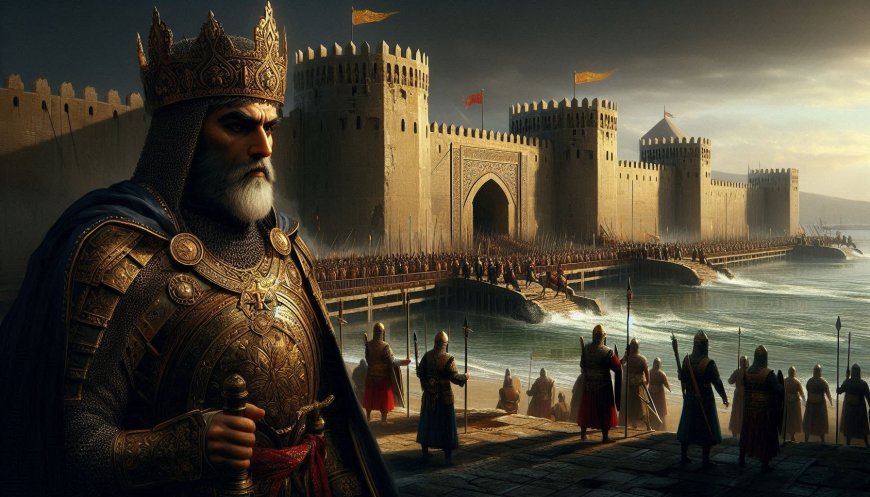Khosrow’s Gambit: The Siege of Antioch
In 540 AD, Khosrow I, the Sasanian ruler, besieged the Byzantine city of Antioch. His strategic brilliance reshaped the balance of power, demonstrating not only his military prowess but also his vision in relocating and rebuilding the city near his capital.

In the year 540 AD, a bold figure stood at the gates of one of the most magnificent cities in the Byzantine Empire. Khosrow I, ruler of the Sasanian Empire, stared out over the jewel that was Antioch, his mind as sharp as the swords of his soldiers. This wasn’t just a siege—it was a statement, a calculated move in a game of empires where every step, every strike, was meticulously planned. For Khosrow, war wasn’t chaos. It was chess, and he was a master.
Antioch, seated proudly on the banks of the Orontes River, was not just a Byzantine stronghold. It was a flourishing hub of culture, commerce, and wealth—its bustling streets filled with merchants, scholars, and soldiers. Taking Antioch wasn’t just audacious; it was the kind of challenge that would define Khosrow’s reign, a victory that would reverberate far beyond the battlefield.
But Khosrow wasn’t interested in brute force alone. He knew that to capture Antioch, he needed to break not just the city’s walls, but its spirit.
Setting the Stage: The Siege Begins
As Khosrow’s army approached, the defenders of Antioch were ready. Strong walls and determined soldiers greeted the Sasanian forces. But Khosrow had something else in mind. He didn’t throw his forces recklessly against the city’s fortifications. Instead, he orchestrated a slow, methodical siege, tightening his grip like a python suffocating its prey.
Supply lines were cut off, and the people of Antioch began to feel the weight of isolation. But Khosrow wasn’t content to let starvation win the day. His siege towers loomed over the city’s walls, battering rams struck with unrelenting force, and a wave of fear swept through the city. Rumors spread of the Sasanian king’s unyielding nature, his reputation as a leader who showed no mercy to those who resisted.
Inside the walls, the defenders began to falter. The brilliance of Khosrow’s tactics wasn’t just in his weaponry—it was in his understanding of human nature. He knew that fear was a far more powerful tool than any battering ram.
And so, after a short but intense siege, the gates of Antioch fell. The proud city, once a beacon of Byzantine strength, now lay at Khosrow’s feet.
The Audacious Aftermath
But Khosrow wasn’t finished. While other conquerors might have razed the city or left it in ruins, Khosrow had grander plans. In an unprecedented move, he ordered the entire population of Antioch to be relocated. They were to build a new city, not in Byzantine lands, but near Khosrow’s capital of Ctesiphon. This city would be known as Weh Antiok Khosrow, or “Khosrow’s Better Antioch.”
Brick by brick, street by street, the people of Antioch recreated their home under Khosrow’s watchful eye. The architecture was the same, the layout nearly identical—but it was clear whose hand now guided their future. By rebuilding the city in his empire, Khosrow demonstrated not only his military prowess but his vision as a ruler. He could destroy, yes—but he could also rebuild, reshape, and assimilate.
In relocating the people of Antioch, Khosrow achieved more than just the expansion of his empire. He integrated a proud Byzantine city into the heart of the Sasanian world, making its people part of his own empire’s cultural and economic fabric. It was a masterstroke in political strategy—a quiet conquest that would serve him for years to come.
The Ripple Effect of Victory
The fall of Antioch sent shockwaves through the Byzantine Empire. One of their most prestigious cities had fallen, its people resettled under a foreign ruler. The capture of Antioch wasn’t just a loss of territory; it was a psychological blow that weakened Byzantine morale and showcased the might of the Sasanian Empire.
In the years that followed, relations between Byzantium and the Sasanians would shift between war and uneasy peace, but the fall of Antioch always hung in the background, a testament to Khosrow’s audacity and brilliance.
Khosrow’s gambit wasn’t just about one city. It was about reshaping the balance of power, about reminding the world that the Sasanian Empire wasn’t to be underestimated. And it was a reminder to his enemies: Khosrow wasn’t just a warrior. He was a strategist, a ruler who played the long game, and one who always kept his eye on the board.
As the sun set over the new Antioch in Sasanian lands, Khosrow’s legacy as a master of both war and diplomacy was sealed, written not just in the annals of history, but in the very streets of the city that now bore his name.
What's Your Reaction?






































































































